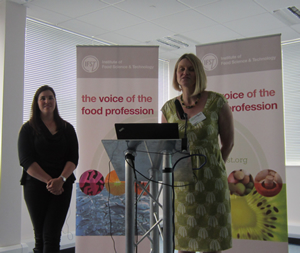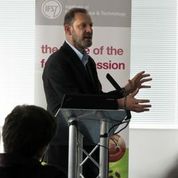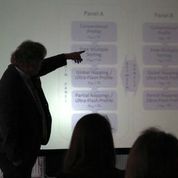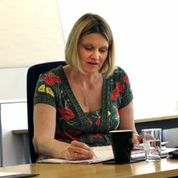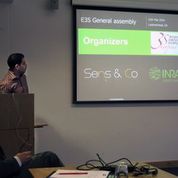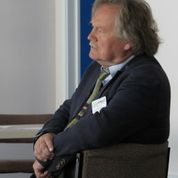FAST FORWARD
EUROPEAN SENSORY SCIENCE SOCIETY
& THE UK PROFESSIONAL FOOD SENSORY GROUP
ANNUAL ONE DAY SENSORY SYMPOSIUM
Monday 13th May 2013, Leatherhead Food Research
In collaboration with the European Sensory Science Society, the UK Professional Food Sensory Group are holding their Annual One Day Sensory Symposium on Monday 13th May 2013. Under the title ‘Fast Forward’ there will be a range of presentations, including talks from Hal MacFie and Erminio Monteleone, oral poster presentations, a poster session and workshops, all looking at developments in sensory and consumer science and the fast pace at which things are moving.
This year we look at how, and speed at which, the sensory and consumer science world is progressing. This event will inspire you to widen your approach by utilising newer, faster technologies and methods. A combination of keynote speakers, workshops and poster presentations will ensure a varied day with plenty of opportunities to expand your sensory network.
CALL FOR POSTER ABSTRACTS: Abstracts should be no longer than 300 words. A selection of abstracts will be chosen for the Oral Poster Session. Please email abstracts to info@carolraithatha.co.uk by 2nd April 2013.
Programme
09:00-09:30 Registration and Refreshments
09:30-09:50 Welcome and Introduction:
Joanne Hort, Chair PFSG, Vice Chair E3S
09:50-10:35 Keynote speaker:
Three Game Changers for Sensory: Tweet, Nap and Slow vs. Fast Thinking
Hal MacFie, Hal MacFie Sensory Training LTD
10:35-11:05 E3S Guest Speaker:
What’s New in Sensory Food Research in Europe?
Erminio Monteleone, European Sensory Science Society Chair & University of Florence
11:05-11:45 Oral poster session including presentation from Caroline Withers (PFSG 2012 Student Award winner) on ‘Taxonomic sorting’
11:45-13.30 Lunch, poster session and networking
13:30-14:30 & 14:40-15:40
Workshop 1:
Panel Performance and Fast!
Lauren Rogers, Lauren Rogers Consultancy, Carol Raithatha, Carol Raithatha Limited & Anne Hasted QI statistics
13:30-14:30 & 14:40-15:40
Workshop 2:
Concept to Consumer: Fast Direction on Product Sensory Optimisation
Sensory Scientists, Leatherhead Food Research, UK
15:40-16:00 Refreshment Break
16:00-16:45 Keynote Speaker:
I Second that Emotion
David Penn, Conquest, UK
16:45-17:00 Question and Answer Session
Conference fees: Registration includes refreshments and lunch:
- £225 (£187.50 + £37.50 VAT) non-IFST/SCI/E3S
- £195 (£162.50 + £32.50 VAT) IFST/SCI/E3S
- £165 (£137.50 + £27.50 VAT) retired
- £100 (£83.33 + £16.67 VAT) full Time Student
Free membership: IFST is offering free digital membership for 6 months to delegates who aren’t already members of the IFST* (*Offer not available to delegates who have taken up this offer at a previous PFSG conference).
How to register: To register, please contact training@leatherheadfood.com
Further information: http://www.leatherheadfood.com/pfsg-conference
The European sensory science community gathered for the 2013 PFSG Conference organised in collaboration with the European Sensory Science Society ‘Fast Forward’, a title chosen to reflect the rapid growth/fast-paced movement of the sensory science field.
Some photos of the conference and of E3S meeting:
The first speaker, Hal MacFie with ‘special guest star’, Thierry Worch, presented Three Game Changers for Sensory: Tweet, Nap and Slow vs. Fast Thinking. Hal opened up the presentation discussing napping, which has also been called ‘DIY Principal Components Analysis’. He described it as a technique used when researchers say ‘I must do something innovative this year’, then it is used that one time and never again. However, it is becoming more popular and literature on the topic is growing. He described how napping is used, citing examples and the positives and negatives. There is ‘lots to commend’ about napping and Hal recommended it, saying ‘it’s worth a second look’.
Thierry Worch then discussed using twitter as a method to find data on products, describing it as a ‘new gold mine’ for companies. Because users (all 500+ million of them) can say whatever they want on Twitter, there’s no reason for them to lie, making it a trustworthy source of information. However, that’s a lot of information to process – around 340 million tweets/day – and companies must search through information, retrieve it, analyse it and make the procedure automatic. This is where the twitteR package of the free statistic software ‘R’ comes in. Thierry took us through two examples, one food related to see how this package works. Twitter data provides ‘real consumers’ in ‘real situations’ but requires a great deal of information processing to get good results.
In the final part of this presentation, Hal looked at Kahneman and Tversky system 1 and 2 thinking- system 1 being our quick, intuitive thinking and system 2 being slower, more rational or “lazy”. He described the effect that these thought processes can have on product testing. He closed with the remarks ‘If you’re still doing blind studies without measuring expectation, you’re stumbling in the dark’.
Erminio Monteleone, founder and former Chair of E3S, was up next with What’s New in Sensory Food Research in Europe? Using the data from the past paper submissions to Eurosense, Erminio skimmed the abstracts and identified the primary keywords from three categories of papers: sensory and consumer, sensory, and consumer. He also looked at trends over the last twenty years of sensory science in Europe.
In the final morning session, we heard six five-minute oral poster presentations – lots of information in very little time! The speakers represented just six of the eighteen posters held in the poster session. During lunch, delegates had the opportunity to look at the posters and vote on their favourite. Perrine Delime, Nottingham University, won with her poster (and presentation) Using Discrimination Tests to identify key components of flavour perception.
Aside from the poster session, delegates also took the long lunch hour to network and have a look around the exhibition stands. There were lots of interesting things going on!
After lunch, there were two workshops. The first, Panel Performance and Fast! was run by PFSG members, Carol Raithatha and Lauren Rogers, and Anne Hasted, QI Statistics. Delegates gathered around computer screens as the speakers took them through various statistical software packages they could use for speeding up panel performance.
In workshop two, Concept to Consumer: Fast Direction on Product Sensory Optimisation, Antoine Goupil de Bouillé and Thierry Worch, each demonstrated two methodologies. Antoine talked about the Kano Model of Customer (Consumer) Satisfaction, which classifies product attributes based on how they are perceived by customers and their effect on consumer satisfaction. Thierry spoke about the Ideal Profiling Method (IPM), which combines perceived and ideal intensities and consumer liking. The audience were able to demonstrate these two methodologies, first coming up with our own skin care product and using Kano modelling and then testing IPM using two skin cream samples.
Delegates then all returned to the main conference hall for the final keynote address by David Penn of Conquest. In I Second that Emotion, David provided information on the role and importance of emotion in building brands – we had emotions and communicated before we had language. He spoke about the use of neuromarketing to find out consumer preferences, highlighting the different techniques as well as the advantages and disadvantages to using them. Although we can observe a brain response, we’ll never truly know how it feels.
(Source: IFST website)




